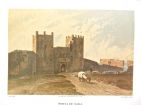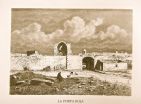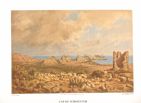
Alcúdia
"Alcúdia, Mallorca’s second largest city is not very well preserved, unbefitting its importance and the ancient splendor it once had. Today, there are numerous other towns on Mallorca which exceed it in both size and importance. It has 1,379 inhabitants and 404 houses, 9 of which are abandoned. 45 houses consist of two stories, while the rest only have one.
Contemplating Alcúdia and Pollença’s double harbor is a true pleasure, the deep blue divided by Cap del Pinar cape into two halves, delimiting the shoreline into soft waves. There is no other place in the Mediterranean with a more favorable location.
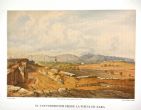 The town’s external wall is shaped like a somewhat irregular rectangle from which 8 bastions still stick out: Baluarte de la Reina to the north, the pointy and very salient Baluarte de San Fernando to the northeast, Baluarte de Santa María to the east and the widest of all, Baluarte de San Felipe to the southeast, Baluarte de San Luis to the south, Baluarte de Santa Teresa to the southwest, Baluarte de San Antonio to the west, and Baluarte del Rey to the northwest. The wall is not very tall and made with large panels roughly joined together with gravel in between.
The town’s external wall is shaped like a somewhat irregular rectangle from which 8 bastions still stick out: Baluarte de la Reina to the north, the pointy and very salient Baluarte de San Fernando to the northeast, Baluarte de Santa María to the east and the widest of all, Baluarte de San Felipe to the southeast, Baluarte de San Luis to the south, Baluarte de Santa Teresa to the southwest, Baluarte de San Antonio to the west, and Baluarte del Rey to the northwest. The wall is not very tall and made with large panels roughly joined together with gravel in between.
The wall has three open gateways. The most interesting one faces east: Porta de Xara also known as Porta del Port. It’s found between two interior towers, creating a small terrace above the dome. From inside the wall, a small staircase climbs up, offering a beautiful view of both Pollença Bay as well as of the Serra range’s most beautiful profiles. A simple half-point arch provides access through the wall to the external one. Porta de Vila Roja, colloquially known as Porta Roja, is simple and undecorated. It still bares the scares of the mechanisms once used to raise the bridge over the moat, a bridge replaced today by a modern one with two open arches.
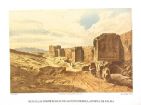 More important is the Porta de Sant Sebastià or Porta de Mallorca, though commonly referred to as Porta de Palma because the road to the capital opens between the Rey and Sant Antoni bastions. The gateway forms a barrel vault ceiling in the thick part of a defensive tower, while Alcúdia’s coat of arms decorate the interior lintel. On the outside, we see the Emperor’s coat of arms surrounded by an inscription which time has made illegible. Above the door of the external wall are three more shields: in the center, Aragón’s coat of arms; the other two have been erased. On the inside is an image of the Virgin which is constantly illuminated by candles, expressing the pious veneration for this object.
More important is the Porta de Sant Sebastià or Porta de Mallorca, though commonly referred to as Porta de Palma because the road to the capital opens between the Rey and Sant Antoni bastions. The gateway forms a barrel vault ceiling in the thick part of a defensive tower, while Alcúdia’s coat of arms decorate the interior lintel. On the outside, we see the Emperor’s coat of arms surrounded by an inscription which time has made illegible. Above the door of the external wall are three more shields: in the center, Aragón’s coat of arms; the other two have been erased. On the inside is an image of the Virgin which is constantly illuminated by candles, expressing the pious veneration for this object.
The long Carrer Major crosses the town from Porta de Palma to Porta de Xara. It was once paved in stone and difficult to travel along. Today it’s been tamped and much more passable.
The larger buildings are found along Carrer de Serra, such as number 11, with “coronelles” arched windows, one of which has been transformed into a Baroque style. There is also number 13, belonging to Joan Billon. The house has ornate Renaissance windows, the one in the middle featuring a castle in the central blazon. This main type is always repeated, though with more or less decoration. The house at number 10 also has a double arched window. Historically interesting is the house found on Carrer de la Roca, where Carlos I of Spain and V of Germany lived during his visit to Alcúdia. Today it belongs to Gabriel Cerdà. It’s on the left side of the street if approaching from Porta de la Xara, the seventh house with a half-point arch entrance. The lintel is crowned by the representation of a golden fleece and has a small, deeply carved Baroque window with a conch shell on top.
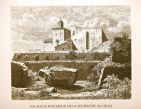 The parish church is dedicated to the Purísima Concepción de María Santísima (Immaculate Conception of the Blessed Virgin Mary). It’s found in a more or less elevated area, near the Santa Teresa bastion, overlooking both wall moats outwardly and the city at its feet inwardly. Externally, we would say the church is a fortress. It is rectangular in shape with a perimeter cornice near the top and crowned by an equally rectangular dome. It has no apse, but two impressively tall pointed arches on both ends. It has 2-meter-thick walls and a vaulted ceiling measuring 40 cm thick with no buttress or flying buttress whatsoever. Only in more recent times have some been added on the part near the moat to restore some of the firmness to the dilapidated walls.
The parish church is dedicated to the Purísima Concepción de María Santísima (Immaculate Conception of the Blessed Virgin Mary). It’s found in a more or less elevated area, near the Santa Teresa bastion, overlooking both wall moats outwardly and the city at its feet inwardly. Externally, we would say the church is a fortress. It is rectangular in shape with a perimeter cornice near the top and crowned by an equally rectangular dome. It has no apse, but two impressively tall pointed arches on both ends. It has 2-meter-thick walls and a vaulted ceiling measuring 40 cm thick with no buttress or flying buttress whatsoever. Only in more recent times have some been added on the part near the moat to restore some of the firmness to the dilapidated walls.
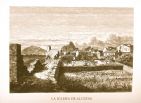 On the side overlooking the city, the right side, there is a side entrance with a small atrium. The only adornment on the main facade is a single ancient rosette. To the right is a tower dating from 1649. It’s divided into four stories without shoring and crowned by a type of small house. To the right of its entrance, towards the church door, is a closed spiral staircase. The church’s interior has a massive Gothic ceiling supported on six arches between which the ribs cross in a simple fashion. The arches originally rested on stone pillars like those we can still see in the not very pretty gallery over the main entrance. Today they are supported on six smooth pilasters that are not very tall. The ribs above start from six leaf-shaped capitals and cross simply under modest keystones. There are two, not very deep chapels on the left side and a third one with a half-point arch. On the right side, there is only one chapel, also not very deep, plus a larger, second one near the main altar. The latter’s chapel has a dome, Romanesque capitals and two miniscule chapels on either side.
On the side overlooking the city, the right side, there is a side entrance with a small atrium. The only adornment on the main facade is a single ancient rosette. To the right is a tower dating from 1649. It’s divided into four stories without shoring and crowned by a type of small house. To the right of its entrance, towards the church door, is a closed spiral staircase. The church’s interior has a massive Gothic ceiling supported on six arches between which the ribs cross in a simple fashion. The arches originally rested on stone pillars like those we can still see in the not very pretty gallery over the main entrance. Today they are supported on six smooth pilasters that are not very tall. The ribs above start from six leaf-shaped capitals and cross simply under modest keystones. There are two, not very deep chapels on the left side and a third one with a half-point arch. On the right side, there is only one chapel, also not very deep, plus a larger, second one near the main altar. The latter’s chapel has a dome, Romanesque capitals and two miniscule chapels on either side.
Not far from Alcúdia is its port. To get there, you have to leave the city through the Porta de Xera gateway. Recently, a good straight road has been built. When building some of the different stretches, they discovered numerous Roman tombs with ceramic vases and other objects.
Leaving a small pine grove on the left and climbing a small hill, our path nears the sea and ends at a sandy beach from which the small dock sticks out. The shore is bordered by numerous regularly shaped plantations. Behind an avenue lined with black mulberry trees, we count up to ten houses, some of them warehouses, and others with a porch supported on pilasters to shelter carriages. The large warehouse with ten segmental windows, three large doors and three rows of columns inside is singular.
A path ascends from Alcúdia’s port, first running along the shore towards the Alcanada or Eucanada estuary to the house with the same name with its aquifer (“avenc”) from which a pump extracts water to fill various troughs. At the base of the house is an extensive vineyard, with terraces of carob and fig trees on its slopes. The nearby garrigue scrubland, by contrast, has been taken over by wild olive trees. The house is simple, with a tower and paved rooftop with a star in the center. A cistern bears the inscription: “Alcanada. 1844”. From here is a beautiful view of Alcúdia’s estuary, the Bec de Ferrutx and Alcanada Island.
Leaving Alcúdia’s port behind us and heading inland towards the southwest, we come to the ruins of the ancient and flourishing city of Pollentia, the precursor to today’s Alcúdia and Pollença.
 Only some remaining walls allow us to conjecture regarding its size. The presence of an amphitheater rising slightly above and to the left of a small house is still clear. There are caves to the left and behind, carved into the sandstone as stables for the animals.
Only some remaining walls allow us to conjecture regarding its size. The presence of an amphitheater rising slightly above and to the left of a small house is still clear. There are caves to the left and behind, carved into the sandstone as stables for the animals.
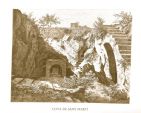 Near Alcúdia Port, to the south of the city, are two barren, almost conical hills, Puig de Sant Martí and Puig de Son Fe, the latter rising to 266.96 m. On the former, full of fennel, is the Sa Cova de Sant Martí cave.
Near Alcúdia Port, to the south of the city, are two barren, almost conical hills, Puig de Sant Martí and Puig de Son Fe, the latter rising to 266.96 m. On the former, full of fennel, is the Sa Cova de Sant Martí cave.
 The “puig” forms a magnificent hillock with magnificent views of the valley of Pollença and Puig de Son Fe, as well as a part of Cap del Pinar. This panoramic view is only exceeded by that offered from the summit of Sant Martí.
The “puig” forms a magnificent hillock with magnificent views of the valley of Pollença and Puig de Son Fe, as well as a part of Cap del Pinar. This panoramic view is only exceeded by that offered from the summit of Sant Martí.
 In front of the space once occupied by ancient Pollentia, a wide valley extends to the south, surrounding a large part of Alcúdia’s estuary and extending to the east towards Sa Pobla. Meanwhile, to the north, it immediately runs into the slopes of Puig de Sant Martí and Son Fe. In its center, this plain formed a great marsh, the most extensive on the island and called Albufera Major. It was barely separated from the coast by some tall and short dunes which didn’t completely succeed in closing off all connections with the sea. Between the marsh and the port is Alcúdia’s solitary cemetery.
In front of the space once occupied by ancient Pollentia, a wide valley extends to the south, surrounding a large part of Alcúdia’s estuary and extending to the east towards Sa Pobla. Meanwhile, to the north, it immediately runs into the slopes of Puig de Sant Martí and Son Fe. In its center, this plain formed a great marsh, the most extensive on the island and called Albufera Major. It was barely separated from the coast by some tall and short dunes which didn’t completely succeed in closing off all connections with the sea. Between the marsh and the port is Alcúdia’s solitary cemetery.
Today and except for in some minor areas, it has been completely dried out by an English firm called “Albufera Company”. It began work to this end in 1863 under the excellent management of Henry Warren. The land taken back from the water is now used for crops. However, it will be difficult for the company to recover the enormous expenditures already dedicated to this project (30 million “reales”, almost 8 million francs). The truth is that is has done a great service to the island, both in terms of sanitizing such an unhealthy area as well as providing occupation for numerous workers.
 Here there are three canals, a large central one and two smaller ones to water crops. They’re separated from each other by thick dykes connected by three bridges. They have four arches over the side canals and five over the central one. The latter, running alongside a wide road, is also ample. Its mouth is found between the “molons” prolonging the artificial river. In terms of the side canals, both are approximately a fourth the width of the central one. The most northern one is already covered by a lot of sand. The southern one is endowed with an additional four-arched bridge in the interior. Water is taken from it to the locks arranged to facilitate and alleviate the work of the machines. If we proceed towards Albufera along the dykes which also serve as roads, we can contemplate all the scope of the great work carried out.
Here there are three canals, a large central one and two smaller ones to water crops. They’re separated from each other by thick dykes connected by three bridges. They have four arches over the side canals and five over the central one. The latter, running alongside a wide road, is also ample. Its mouth is found between the “molons” prolonging the artificial river. In terms of the side canals, both are approximately a fourth the width of the central one. The most northern one is already covered by a lot of sand. The southern one is endowed with an additional four-arched bridge in the interior. Water is taken from it to the locks arranged to facilitate and alleviate the work of the machines. If we proceed towards Albufera along the dykes which also serve as roads, we can contemplate all the scope of the great work carried out.
Near the latter, in addition to the so-called Estany d’En Bauló pond found towards the central part of the great marsh is another marshy area only 1 km from the city towards Pollença Bay. This area is known as La Albufereta, a neighbor to both cities. It has a circumference of only 2-3 km, and its depth is variable though frankly diminishing. La Albufereta connects to the sea which is very close by. But, given that its depth is greater here than the sea, it never completely empties out its brackish water. A creek, El Rec, also known as Torrent de la Vall de Colonya, empties into it like others. Amongst these, the most important is Torrent d’En Burgues. The “Albufera Company” has purchased La Albufereta with the aim of drying it out. Unfortunately, this project, which would do so much from a health perspective for Alcúdia, Pollença and the entire area, seems to have been abandoned due to the little profit earned from the Albufera project.
The before-mentioned Rec (canal) is the only water course on Mallorca which always has water. It doesn’t stop emptying water into La Albufereta not even in the driest and hottest summers. It is only 2 km long and 7-8 m wide. Numerous monk’s pepper plants run alongside it as occurs with all the torrents emptying into Pollença’s marsh.
One of the most interesting excursions from Alcúdia is the one taking us to Cap del Pinar peninsula which separates the two large inlets, serving as a distinguishing note in the otherwise monotonous coast. On the slope of this elevated promontory on Alcúdia’s side and 8.3 km from the city is the Nostra Senyora de la Victòria sanctuary. A windmill separates the fork from the path, leading to that pilgrimage site through thick foliage. To the left, on Pollença’s side, are the houses of s’Hort d’En Serra Hort del Moro, both with defensive towers.
 There are some vineyards here and there, and a small forest of pine trees and Holm oaks next to a sandstone quarry stands out. The path takes several turns, offering us various images of the city and the faraway Serra range. To the left is the sandstone promontory called Castell de Manresa, with traces of past mining in the quarry. This promontory forms a small sandy hill followed by a plain with a well and vineyard. At the end is the rocky mass on which the ruinous castle stands, today under siege by all types of tree spurges with pine trees and prickly pears serving as reinforcement on one of the sides. The path soon descends amongst fan palms towards Platja des Mal Pas beach were we find the Coconar canal spotted with pine trees. The path now runs along the torn up beach and then ascends once more amongst fan palms. We thus reach a plain protected on the sea side by a coastal battery known as Guardia. Excepting the picturesque and small pine groves scattered around the place, the area is pure scrubland.
There are some vineyards here and there, and a small forest of pine trees and Holm oaks next to a sandstone quarry stands out. The path takes several turns, offering us various images of the city and the faraway Serra range. To the left is the sandstone promontory called Castell de Manresa, with traces of past mining in the quarry. This promontory forms a small sandy hill followed by a plain with a well and vineyard. At the end is the rocky mass on which the ruinous castle stands, today under siege by all types of tree spurges with pine trees and prickly pears serving as reinforcement on one of the sides. The path soon descends amongst fan palms towards Platja des Mal Pas beach were we find the Coconar canal spotted with pine trees. The path now runs along the torn up beach and then ascends once more amongst fan palms. We thus reach a plain protected on the sea side by a coastal battery known as Guardia. Excepting the picturesque and small pine groves scattered around the place, the area is pure scrubland.
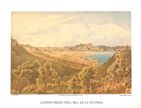 We pass by a spring which flows along a type of noria supported on two columns. Above the wall framing the water’s course, two old black poplars grow under the shelter of a thick wall on which we can read the date, 1648. At the base of the wall is a cistern and small garden. The church is on an esplanade projected on an outcropping over the lower plain. From its foothills is a splendid view of the surroundings, while the valley returns a sonorous echo. The church occupies the entire bottom part of the construction. Externally, it has a rectangular door, a niche with a small statue and a rosette, as well as the refectory window with balustrade protected up high by an arrow-slit.
We pass by a spring which flows along a type of noria supported on two columns. Above the wall framing the water’s course, two old black poplars grow under the shelter of a thick wall on which we can read the date, 1648. At the base of the wall is a cistern and small garden. The church is on an esplanade projected on an outcropping over the lower plain. From its foothills is a splendid view of the surroundings, while the valley returns a sonorous echo. The church occupies the entire bottom part of the construction. Externally, it has a rectangular door, a niche with a small statue and a rosette, as well as the refectory window with balustrade protected up high by an arrow-slit.
A scantly profited quarry opens up next to the Victòria sanctuary, with beautiful marble streaked in black and yellow. Behind the church, the presence of three crosses in the place known as El Calvari stands out. The path to the “talaia” (watchtower) starts from here, running along the pine-covered slope of Lardenà canal. The rocky walls reveal numerous cavities and caves.
The Atalaia de Alcúdia watchtower is 451.20 m above sea level. It is circular in construction and surrounded above by a cornice on which arrow-slits once opened. The interior consists of a domed chamber. The easiest climb up is from the side facing Alcúdia.
In front of the small Clot house, a path begins along rocky terrain, moving along the slope of La Falguera passing next to a spring. Numerous rosemary bushes and innumerable mastics, reeds and fan palms represent the vegetation here. From the top of a pass between the rocks, we overlook Pollença Bay, Coll dels Jueus and Pedra Roja. On the red ledge of the latter is a cannon, its servers or guardians using a hole in the wall to enter and exit its lair."
Archduke Ludwig Salvator of Austria. Las Baleares por la palabra y el grabado. Majorca: The island. Ed. Sa Nostra, Caja de Baleares. Palma de Mallorca. 1982.









